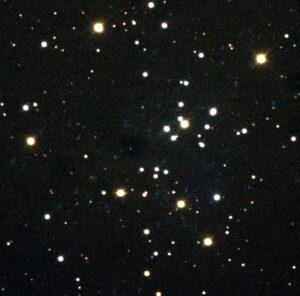NGC 3680 is an intermediate age, open cluster located in the Southern constellation Centaurus. It was first discovered by Scottish astronomer James Dunlop in 1826 and is estimated to be over 1.2 billion years old. Interestingly, the NGC 3680 star cluster was classified as containing less than 50 stars, yet the number of stars making up an open cluster can range anywhere from tens to a couple thousand stars!
In a recent study, Peña Suárez et al (2018) analyzed a small number of red giant stars found in three open clusters, including that of NGC 3680. It was determined that the s-process element abundances in these three clusters is higher than in older clusters. As well, a trend in the [Y/Mg]- age relation was observed between the three clusters. This observation provides insight that might suggest the possibility for the [Y/Mg] ratio to be used as a clock for the red giants.
In order to study NGC 3680 and investigate the relationships between the colours, brightnesses, and the age and chemical composition of the cluster as a whole, I used the Skynet Robotic Telescope webpage to collect 15 images of this cluster to analyse. The filters B, V, and R with the corresponding exposure times of 75.0, 35.0, and 20.0 seconds were used on 5 images each, and the telescope PROMT-MO-1, located at the Meckering Observatory, was used to capture these images. All images captured were required to be taken with the same telescope and using the three filters. The images were scheduled to repeat 5 times with an hour between each. Once the images were completed, I used Afterglow to align and stack, as well as photometer all 15 images, in order to create a colour image and a csv file of NGC 3680. In addition, Cluster Astromancer was then utilized to create V vs B-V color-magnitude diagrams of NGC 3680. By uploading the csv file from Afterglow to Cluster Astromancer, I was able to remove all the unnecessary field stars located within the data, as well as fetch more data using Gaia. With these parameters met, a nice isochrone/ photometry HR diagram was created of NGC 3680. From this process, I found these basic results regarding my cluster:
| Proper Motion RA (mas/yr) | Proper Motion Dec (mas/yr) | Distance (kpc) | Log (Age(yrs))
|
Metallicity (solar) | E(B-V) |
| 171.39 | -43.24 | 1.06 | 9.25 | 0.05 | 0.06 |
The following HR diagrams of NGC 3680 were created using the previous determined data:




Once the accurate E(B-V) value was obtained from these images, a de-reddened colour image of NGC 3680 was created:

The point of analysing this cluster was not only to collect new results for potential future reference, but for me to familiarize myself with the process of collecting data. The time-consuming process of collecting and analysing data on the NGC 3680 star cluster proved worthwhile as the results provided useful information about this cluster! For example, I learned that this is a rather tiny cluster, with my data suggesting it has a star count of only 48 stars. However, having such a tiny cluster made it rather difficult to analyse when it came to making HR diagrams of the photometry. It was hard trying to fit the isochrone line to the points because of the lack of stars to match the line up with. By looking at the results gathered about NGC 3680’s interstellar reddening, it can now be determined that a value of 0.06 means there is not a lot of astronomical dust surrounding the cluster to distort its emitted light. Moreover, the cluster has a solar metallicity of 0.05. Stars with lower metallicities tend to be older in age, so if we compare its metallicity to its log age of 9.25, it makes sense that it was found to be classified as an intermediately aged star cluster.
Having completed my analysis, I feel as I have gained a better understanding of the practical applications in the Astronomy field. As well, it is interesting to know that there are numerous different websites out there that are designated to providing specific and useful information about stars. I have gained a new appreciation for the people who have to spend countless hours collecting data such as I did.